Assessing the Spatio-Temporal Features and Mechanisms of Symmetric Instability Activity Probability in the Central Part of the South China Sea Based on a Regional Ocean Model
Abstract
1. Introduction
2. Model Description and Methods
2.1. Observation Data
2.2. Model Setup
2.3. Definition of SI Activity
3. Results
3.1. Model Validation
3.2. The Spatio-Temporal Features of SI Activity
4. Mechanisms Analysis
4.1. Ertel Potential Vorticity Analysis
4.2. Analysis of Two Negative PV Injection
5. Discussion
6. Conclusions
Supplementary Materials
Author Contributions
Funding
Institutional Review Board Statement
Informed Consent Statement
Data Availability Statement
Acknowledgments
Conflicts of Interest
References
- McWilliams, J.C. Submesoscale currents in the ocean. Proc. R. Soc. A Math. Phys. Eng. Sci. 2016, 472, 20160117. [Google Scholar] [CrossRef] [PubMed]
- Qiu, B.; Chen, S.; Klein, P.; Sasaki, H.; Sasai, Y. Seasonal Mesoscale and Submesoscale Eddy Variability along the North Pacific Subtropical Countercurrent. J. Phys. Oceanogr. 2014, 44, 3079–3098. [Google Scholar] [CrossRef]
- Zhang, Z.; Zhang, X.; Qiu, B.; Zhao, W.; Zhou, C.; Huang, X.; Tian, J. Submesoscale Currents in the Subtropical Upper Ocean Observed by Long-Term High-Resolution Mooring Arrays. J. Phys. Oceanogr. 2021, 51, 187–206. [Google Scholar] [CrossRef]
- Cao, H.; Fox-Kemper, B.; Jing, Z. Submesoscale eddies in the upper ocean of the kuroshio extension from high-resolution simulation: Energy budget. J. Phys. Oceanogr. 2021, 51, 2181–2201. [Google Scholar] [CrossRef]
- Capet, X.; McWilliams, J.C.; Molemaker, M.J.; Shchepetkin, A.F. Mesoscale to Submesoscale Transition in the California Current System. Part III: Energy Balance and Flux. J. Phys. Oceanogr. 2008, 38, 2256–2269. [Google Scholar] [CrossRef]
- Gula, J.; Molemaker, M.J.; McWilliams, J.C. Topographic generation of submesoscale centrifugal instability and energy dissipation. Nat. Commun. 2016, 7, 12811. [Google Scholar] [CrossRef] [PubMed]
- Yang, Q.; Zhao, W.; Liang, X.; Dong, J.; Tian, J. Elevated Mixing in the Periphery of Mesoscale Eddies in the South China Sea. J. Phys. Oceanogr. 2017, 47, 895–907. [Google Scholar] [CrossRef]
- Lévy, M.; Iovino, D.; Resplandy, L.; Klein, P.; Madec, G.; Tréguier, A.M.; Masson, S.; Takahashi, K. Large-scale impacts of submesoscale dynamics on phytoplankton: Local and remote effects. Ocean Model. 2012, 43–44, 77–93. [Google Scholar] [CrossRef]
- Su, Z.; Wang, J.; Klein, P.; Thompson, A.F.; Menemenlis, D. Ocean submesoscales as a key component of the global heat budget. Nat. Commun. 2018, 9, 775. [Google Scholar] [CrossRef]
- Jing, Z.; Fox-Kemper, B.; Cao, H.; Zheng, R.; Du, Y. Submesoscale Fronts and Their Dynamical Processes Associated with Symmetric Instability in the Northwest Pacific Subtropical Ocean. J. Phys. Oceanogr. 2021, 51, 83–100. [Google Scholar] [CrossRef]
- Thomas, L.N.; Taylor, J.R.; D’Asaro, E.A.; Lee, C.M.; Klymak, J.M.; Shcherbina, A. Symmetric Instability, Inertial Oscillations, and Turbulence at the Gulf Stream Front. J. Phys. Oceanogr. 2016, 46, 197–217. [Google Scholar] [CrossRef]
- Dong, J.; Fox-Kemper, B.; Zhu, J.; Dong, C. Application of Symmetric Instability Parameterization in the Coastal and Regional Ocean Community Model (CROCO). J. Adv. Model. Earth Syst. 2021, 13, e2020MS002302. [Google Scholar] [CrossRef]
- Sun, Z.; Zhang, Z.; Qiu, B.; Zhou, C.; Zhao, W.; Tian, J. Subsurface Mesoscale Eddies Observed in the Northeastern South China Sea: Dynamic Features and Water Mass Transport. J. Phys. Oceanogr. 2022, 52, 841–855. [Google Scholar] [CrossRef]
- Zhang, Z.; Zhao, W.; Qiu, B.; Tian, J. Anticyclonic Eddy Sheddings from Kuroshio Loop and the Accompanying Cyclonic Eddy in the Northeastern South China Sea. J. Phys. Oceanogr. 2017, 47, 1243–1259. [Google Scholar] [CrossRef]
- Zhang, Z.; Zhang, Y.; Qiu, B.; Sasaki, H.; Sun, Z.; Zhang, X.; Zhao, W.; Tian, J. Spatiotemporal Characteristics and Generation Mechanisms of Submesoscale Currents in the Northeastern South China Sea Revealed by Numerical Simulations. J. Geophys. Res. Ocean. 2020, 125, e2019JC015404. [Google Scholar] [CrossRef]
- Cao, H.; Meng, X.; Jing, Z.; Yang, X. High-resolution simulation of upper-ocean submesoscale variability in the South China Sea: Spatial and seasonal dynamical regimes. Acta Oceanol. Sin. 2022, 41, 26–41. [Google Scholar] [CrossRef]
- Dong, J.; Fox-Kemper, B.; Zhang, H.; Dong, C. The Scale and Activity of Symmetric Instability Estimated from a Global Submesoscale-Permitting Ocean Model. J. Phys. Oceanogr. 2021, 51, 1655–1670. [Google Scholar] [CrossRef]
- Bachman, S.D.; Fox-Kemper, B.; Taylor, J.R.; Thomas, L.N. Parameterization of Frontal Symmetric Instabilities. I: Theory for Resolved Fronts. Ocean Model. 2017, 109, 72–95. [Google Scholar] [CrossRef]
- Yu, X.; Naveira Garabato, A.C.; Martin, A.P.; Gwyn Evans, D.; Su, Z. Wind-Forced Symmetric Instability at a Transient Mid-Ocean Front. Geophys. Res. Lett. 2019, 46, 11281–11291. [Google Scholar] [CrossRef]
- Dong, J.; Fox-Kemper, B.; Zhang, H.; Dong, C. The Scale of Submesoscale Baroclinic Instability Globally. J. Phys. Oceanogr. 2020, 50, 2649–2667. [Google Scholar] [CrossRef]
- Good, S.A.; Martin, M.J.; Rayner, N.A. EN4: Quality controlled ocean temperature and salinity profiles and monthly objective analyses with uncertainty estimates. J. Geophys. Res. Ocean. 2013, 118, 6704–6716. [Google Scholar] [CrossRef]
- Huang, B.; Liu, C.; Banzon, V.; Freeman, E.; Graham, G.; Hankins, B.; Smith, T.; Zhang, H.-M. Improvements of the Daily Optimum Interpolation Sea Surface Temperature (DOISST) Version 2.1. J. Clim. 2021, 34, 2923–2939. [Google Scholar] [CrossRef]
- Jullien, S.; Caillaud, M.; Benshila, R.; Bordois, L.; Cambon, G.; Dumas, F.; Gentil, S.L.; Lemarié, F.; Marchesiello, P.; Theetten, S. Technical and Numerical Doc. 2019. Available online: https://www.croco-ocean.org/documentation/ (accessed on 8 June 2021).
- Debreu, L.; Blayo, E. Two-way embedding algorithms: A review. Ocean. Dyn. 2008, 58, 415–428. [Google Scholar] [CrossRef]
- Large, W.G.; McWilliams, J.C.; Doney, S.C. Oceanic vertical mixing: A review and a model with a nonlocal boundary layer parameterization. Rev. Geophys. 1994, 32, 363–403. [Google Scholar] [CrossRef]
- Thomas, L.N.; Taylor, J.R.; Ferrari, R.; Joyce, T.M. Symmetric instability in the Gulf Stream. Deep. Sea Res. Part II Top. Stud. Oceanogr. 2013, 91, 96–110. [Google Scholar] [CrossRef]
- Thomas, L.N.; Taylor, J.R. Reduction of the usable wind-work on the general circulation by forced symmetric instability. Geophys. Res. Lett. 2010, 37, L18606. [Google Scholar] [CrossRef]
- Thomas, L.N. Destruction of Potential Vorticity by Winds. J. Phys. Oceanogr. 2005, 35, 2457–2466. [Google Scholar] [CrossRef]
- Dong, J.; Fox-Kemper, B.; Jing, Z.; Yang, Q.; Tian, J.; Dong, C. Turbulent Dissipation in the Surface Mixed Layer of an Anticyclonic Mesoscale Eddy in the South China Sea. Geophys. Res. Lett. 2022, 49, e2022GL100016. [Google Scholar] [CrossRef]
- Cao, H.; Jing, Z. Submesoscale Ageostrophic Motions Within and Below the Mixed Layer of the Northwestern Pacific Ocean. J. Geophys. Res. Ocean. 2022, 127, e2021JC017812. [Google Scholar] [CrossRef]
- Zhang, Z.; Zhao, W.; Tian, J.; Liang, X. A mesoscale eddy pair southwest of Taiwan and its influence on deep circulation. J. Geophys. Res. Ocean. 2013, 118, 6479–6494. [Google Scholar] [CrossRef]
- Charney, J.G. Geostrophic Turbulence. J. Atmos. Sci. 1971, 28, 1087–1095. [Google Scholar] [CrossRef]
- Callies, J.; Ferrari, R. Interpreting Energy and Tracer Spectra of Upper-Ocean Turbulence in the Submesoscale Range (1–200 km). J. Phys. Oceanogr. 2013, 43, 2456–2474. [Google Scholar] [CrossRef]
- Capet, X.; McWilliams, J.C.; Molemaker, M.J.; Shchepetkin, A.F. Mesoscale to Submesoscale Transition in the California Current System. Part I: Flow Structure, Eddy Flux, and Observational Tests. J. Phys. Oceanogr. 2008, 38, 29–43. [Google Scholar] [CrossRef]
- Capet, X.; McWilliams, J.C.; Molemaker, M.J.; Shchepetkin, A. Mesoscale to submesoscale transition in the California Current System. Part II: Frontal processes. J. Phys. Oceanogr. 2008, 38, 44–64. [Google Scholar] [CrossRef]
- Zhong, Y.; Bracco, A.; Tian, J.; Dong, J.; Zhao, W.; Zhang, Z. Observed and simulated submesoscale vertical pump of an anticyclonic eddy in the South China Sea. Sci. Rep. 2017, 7, 44011. [Google Scholar] [CrossRef]
- Thompson, A.F.; Lazar, A.; Buckingham, C.; Naveira Garabato, A.C.; Damerell, G.M.; Heywood, K.J. Open-Ocean Submesoscale Motions: A Full Seasonal Cycle of Mixed Layer Instabilities from Gliders. J. Phys. Oceanogr. 2016, 46, 1285–1307. [Google Scholar] [CrossRef]
- McWilliams, J.C. Submesoscale surface fronts and filaments: Secondary circulation, buoyancy flux, and frontogenesis. J. Fluid Mech. 2017, 823, 391–432. [Google Scholar] [CrossRef]
- Hoskins, B.J. The mathematical theory of frontogenesis. Annu. Rev. Fluid Mech. 1982, 14, 131–151. [Google Scholar] [CrossRef]
- Schubert, R.; Gula, J.; Greatbatch, R.J.; Baschek, B.; Biastoch, A. The Submesoscale Kinetic Energy Cascade: Mesoscale Absorption of Submesoscale Mixed Layer Eddies and Frontal Downscale Fluxes. J. Phys. Oceanogr. 2020, 50, 2573–2589. [Google Scholar] [CrossRef]
- Haine, T.W.N.; Marshall, J. Gravitational, Symmetric, and Baroclinic Instability of the Ocean Mixed Layer. J. Phys. Oceanogr. 1998, 28, 634–658. [Google Scholar] [CrossRef]
- de Boyer Montégut, C.; Madec, G.; Fischer, A.S.; Lazar, A.; Iudicone, D. Mixed layer depth over the global ocean: An examination of profile data and a profile-based climatology. J. Geophys. Res. Ocean. 2004, 109, C12003. [Google Scholar] [CrossRef]
- Brannigan, L. Intense submesoscale upwelling in anticyclonic eddies. Geophys. Res. Lett. 2016, 43, 3360–3369. [Google Scholar] [CrossRef]
- Buckingham, C.E.; Gula, J.; Carton, X. The Role of Curvature in Modifying Frontal Instabilities. Part I: Review of Theory and Presentation of a Nondimensional Instability Criterion. J. Phys. Oceanogr. 2021, 51, 299–315. [Google Scholar] [CrossRef]
- Taylor, J.R.; Ferrari, R. Buoyancy and Wind-Driven Convection at Mixed Layer Density Fronts. J. Phys. Oceanogr. 2010, 40, 1222–1242. [Google Scholar] [CrossRef]
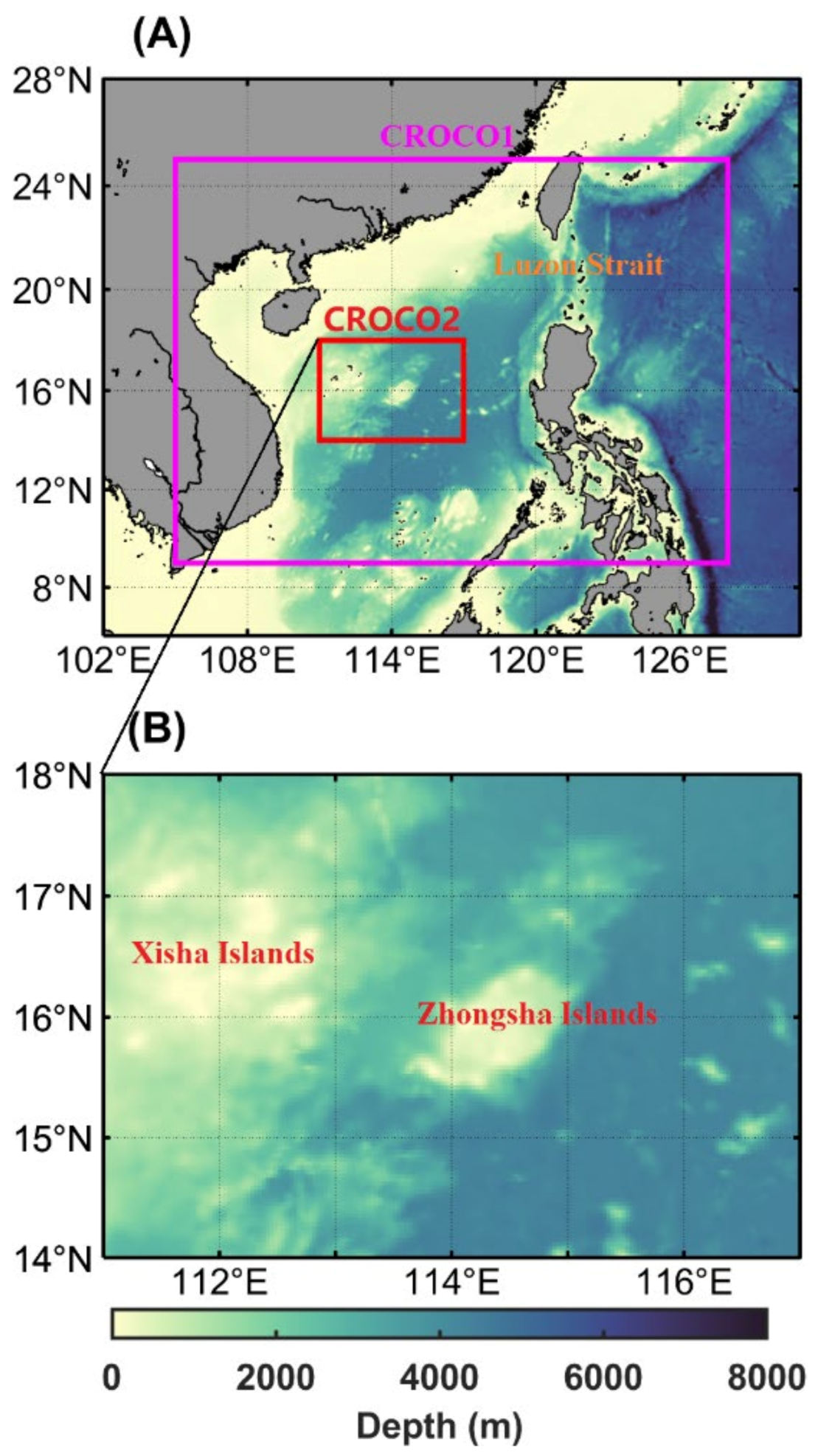
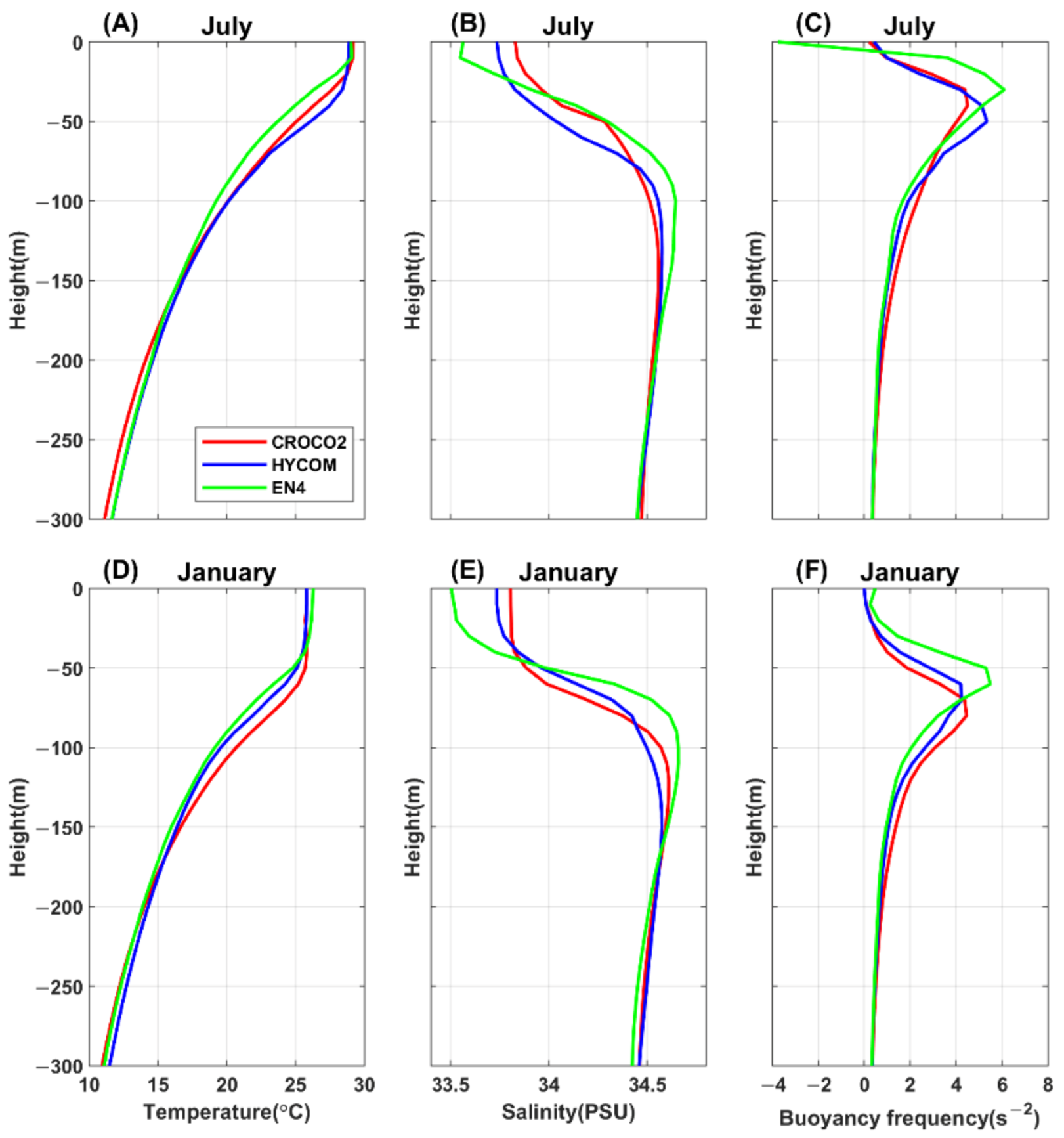

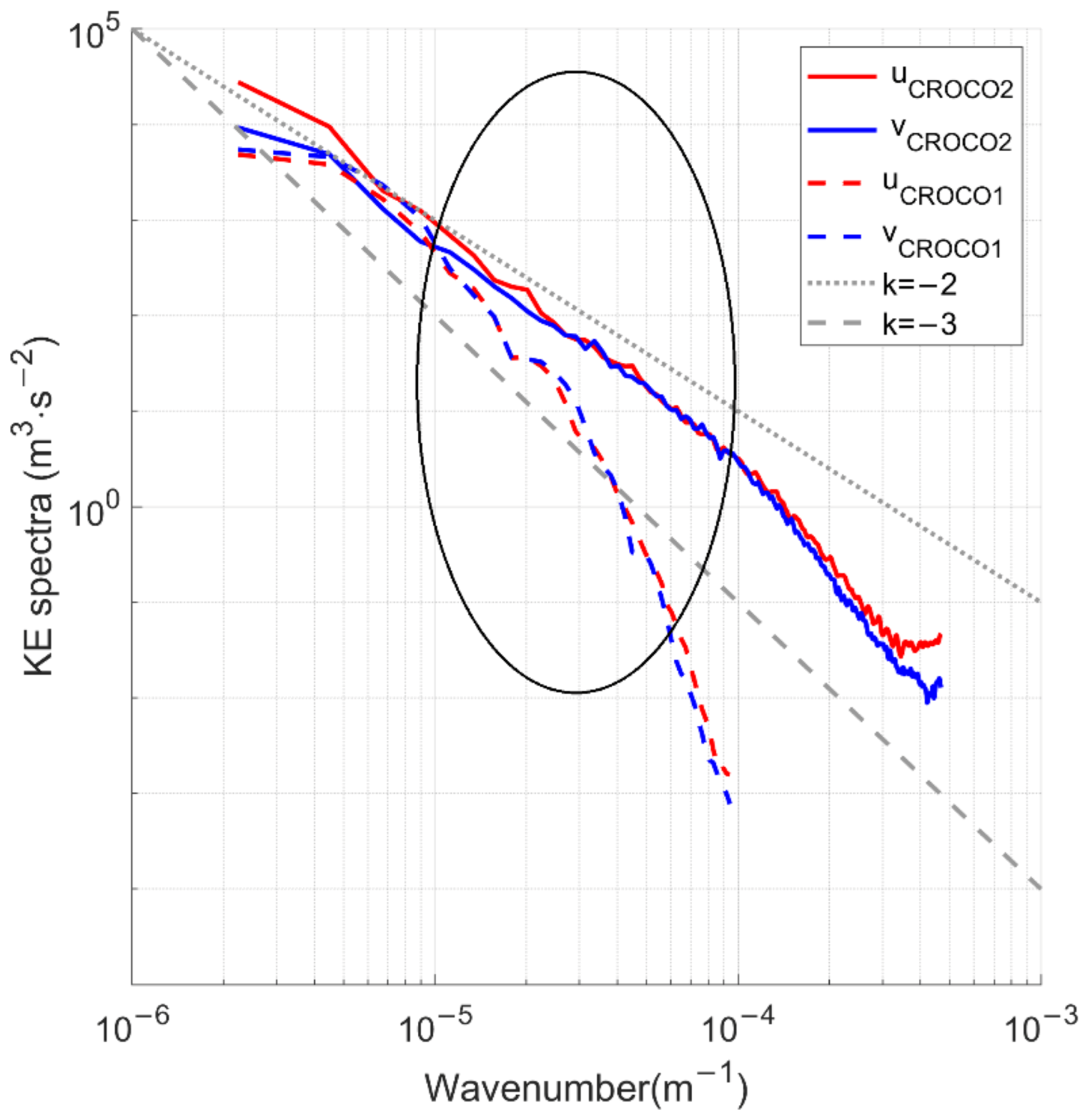
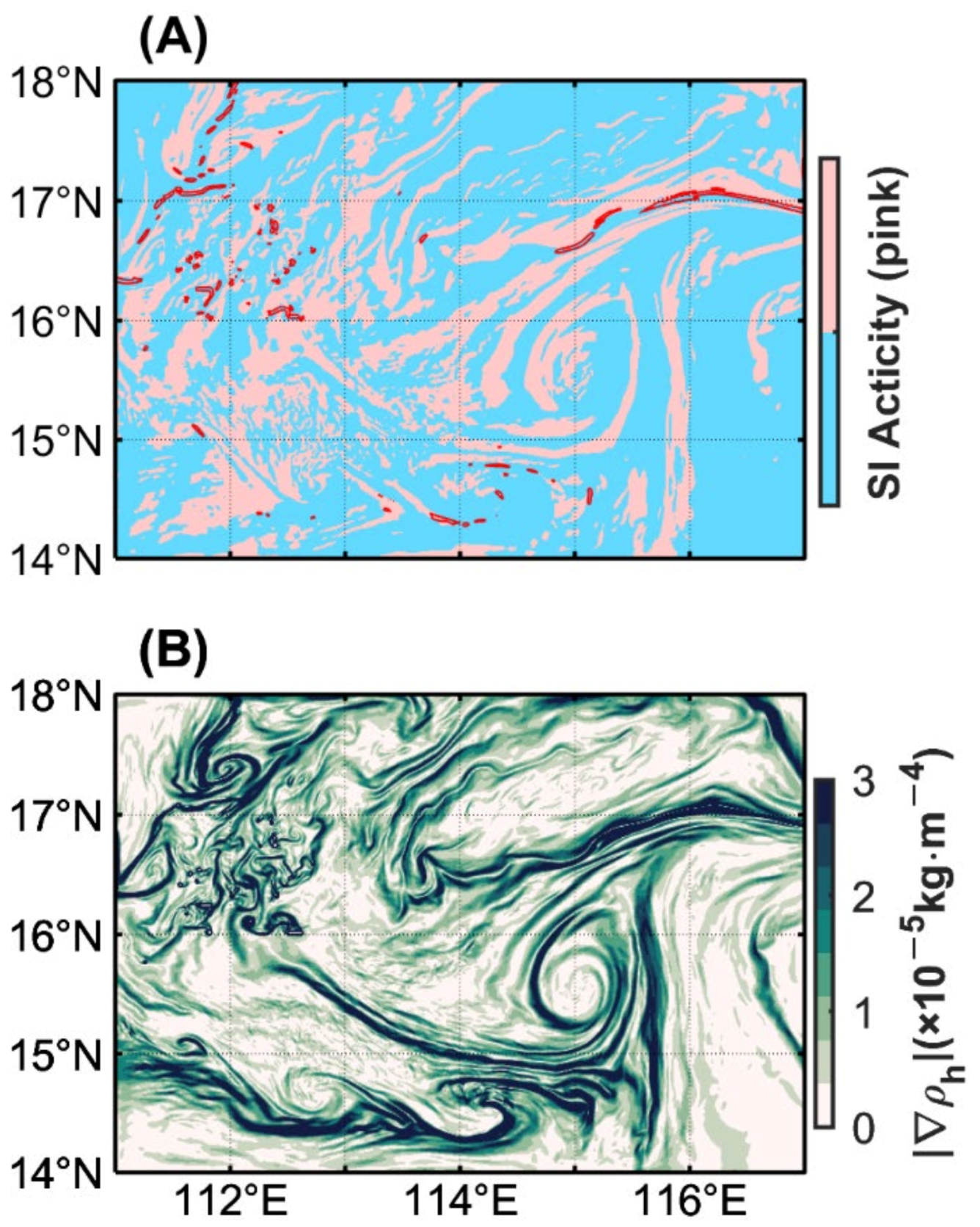
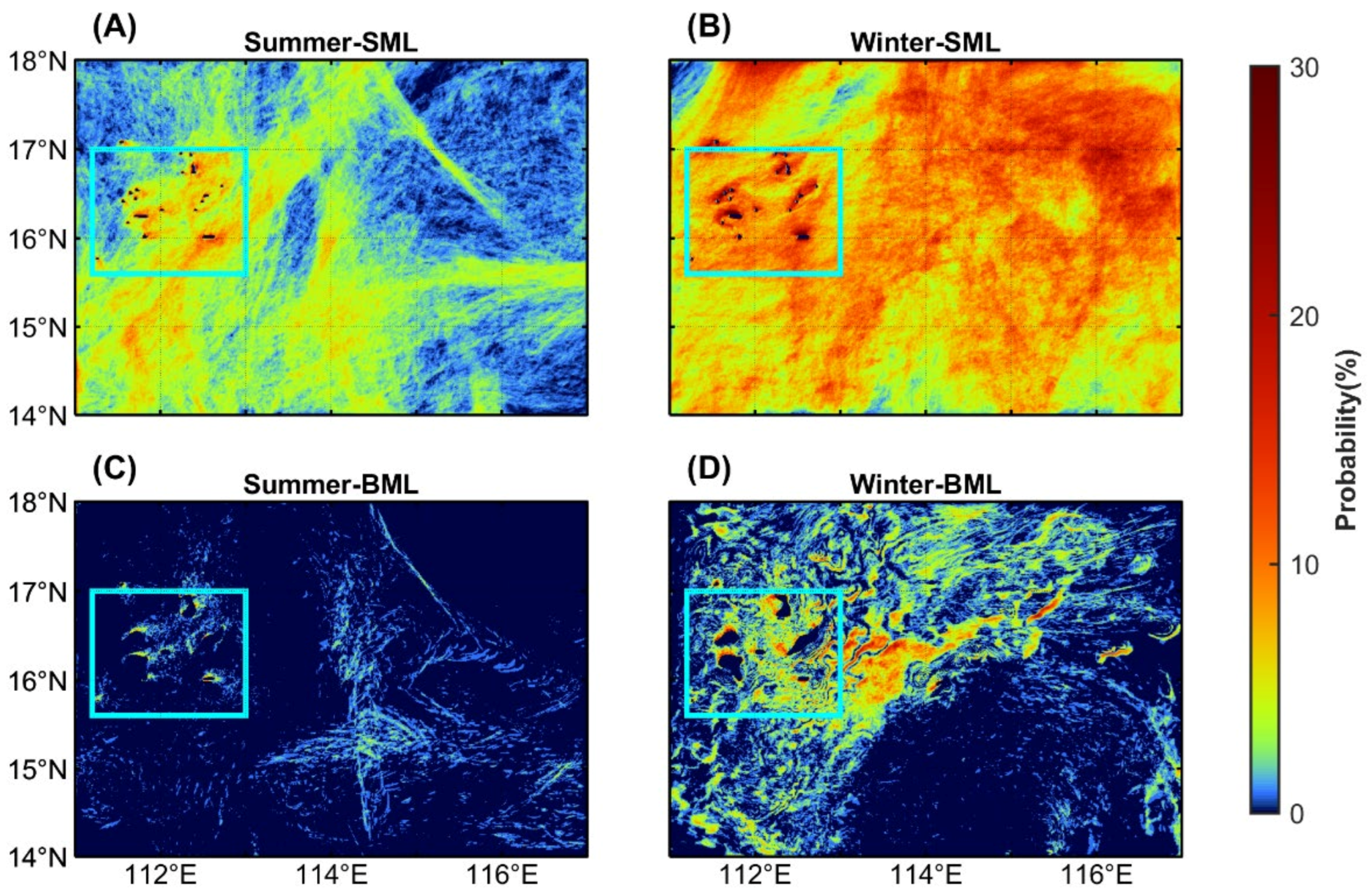
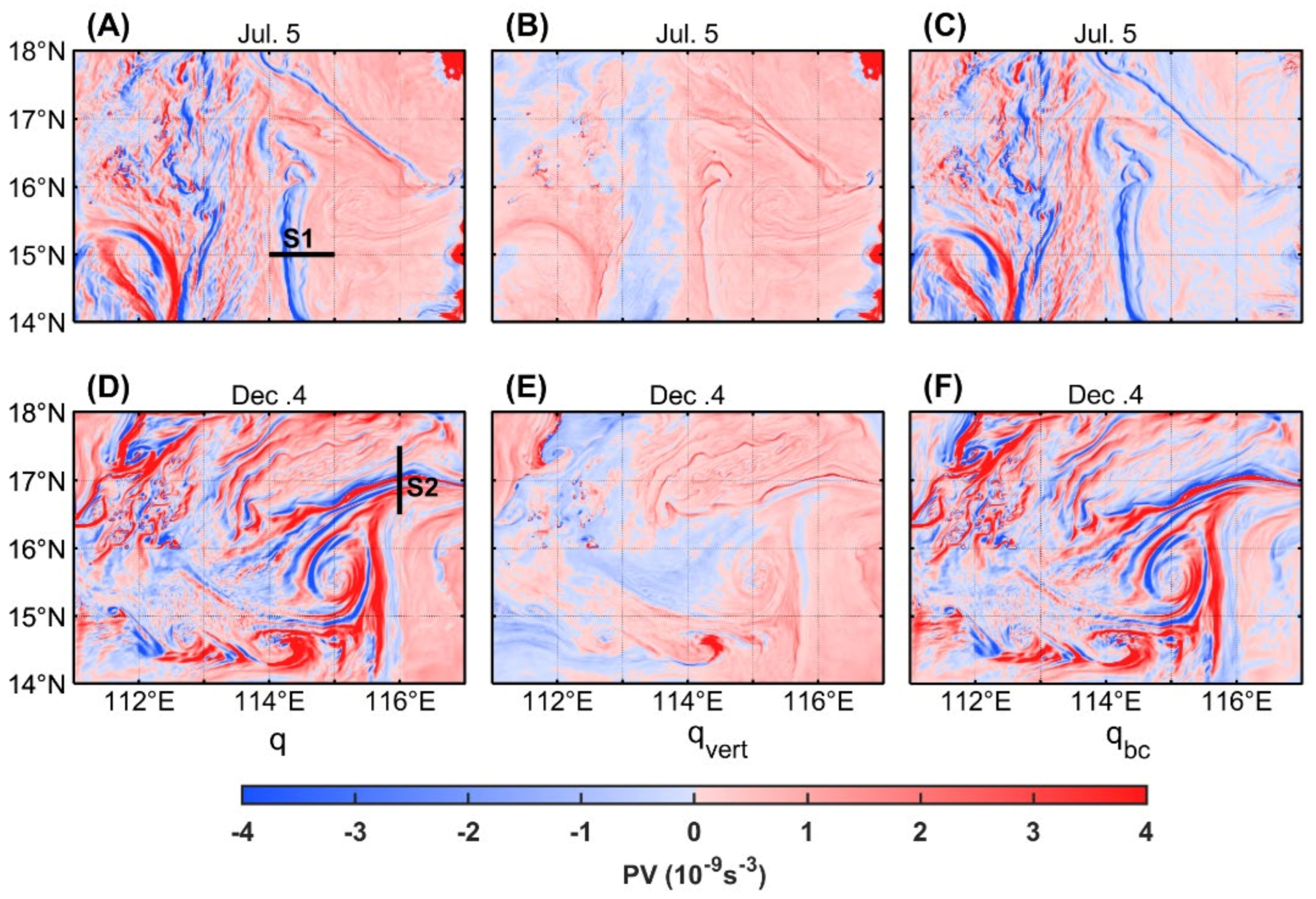
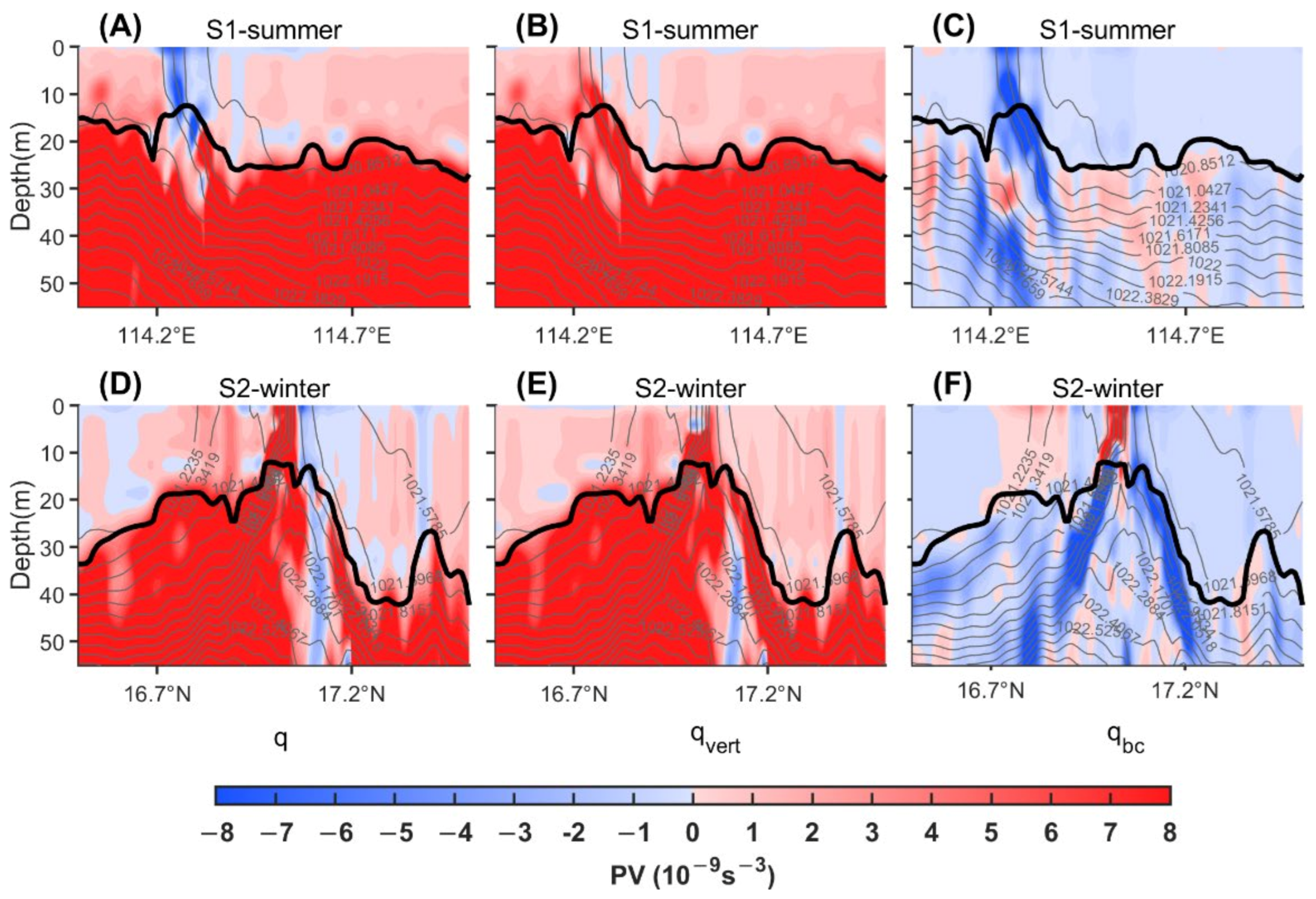
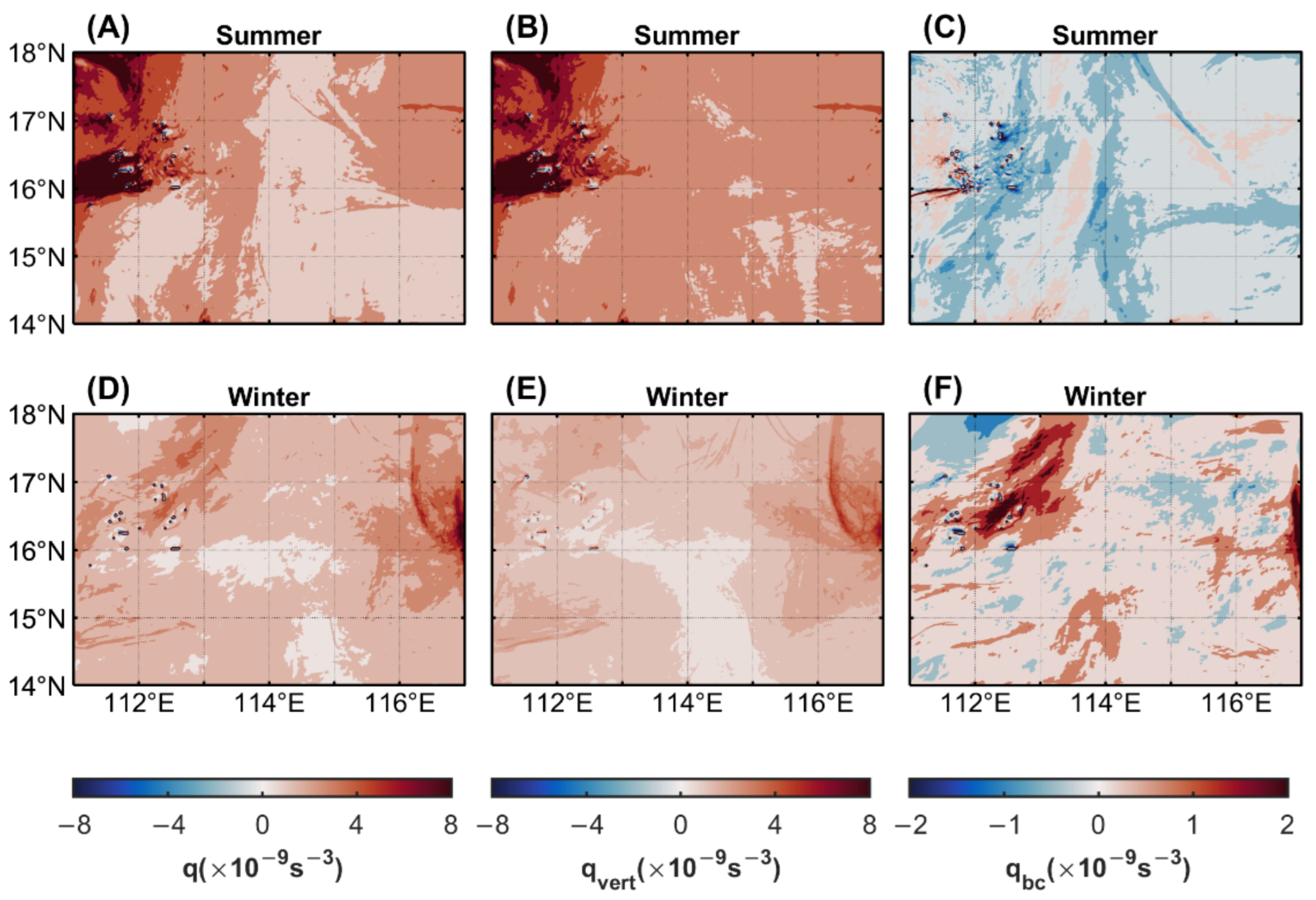
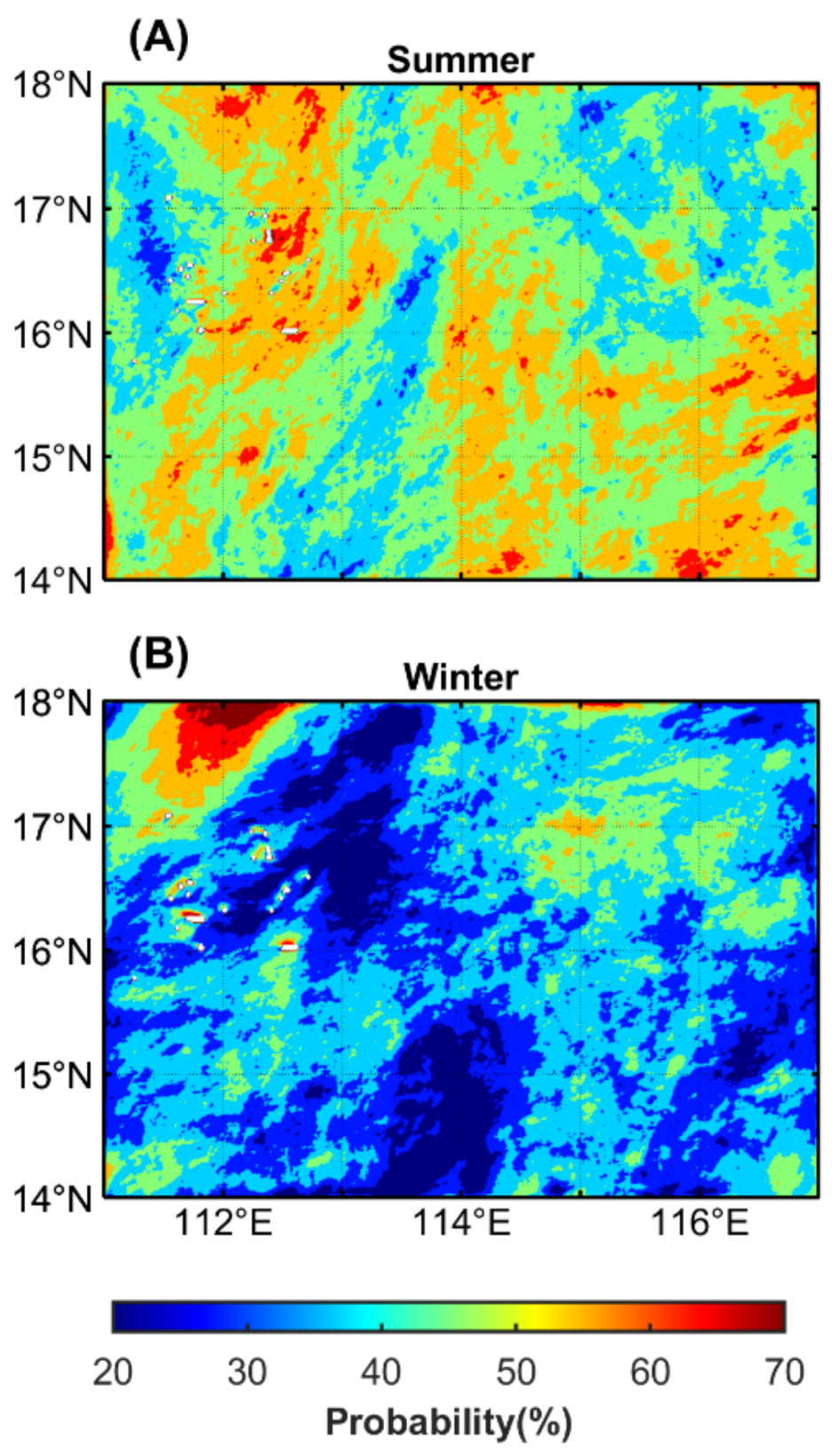
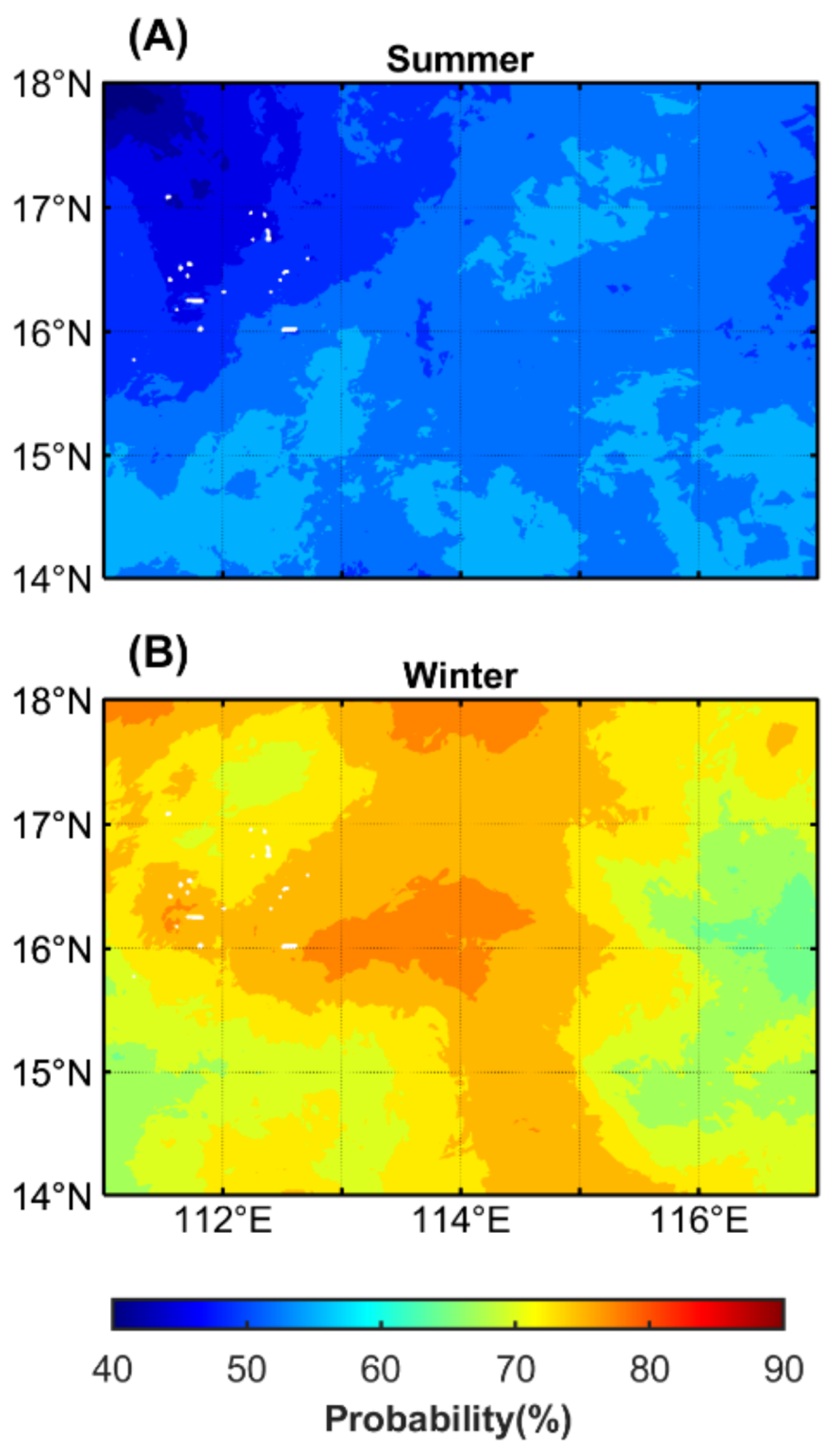

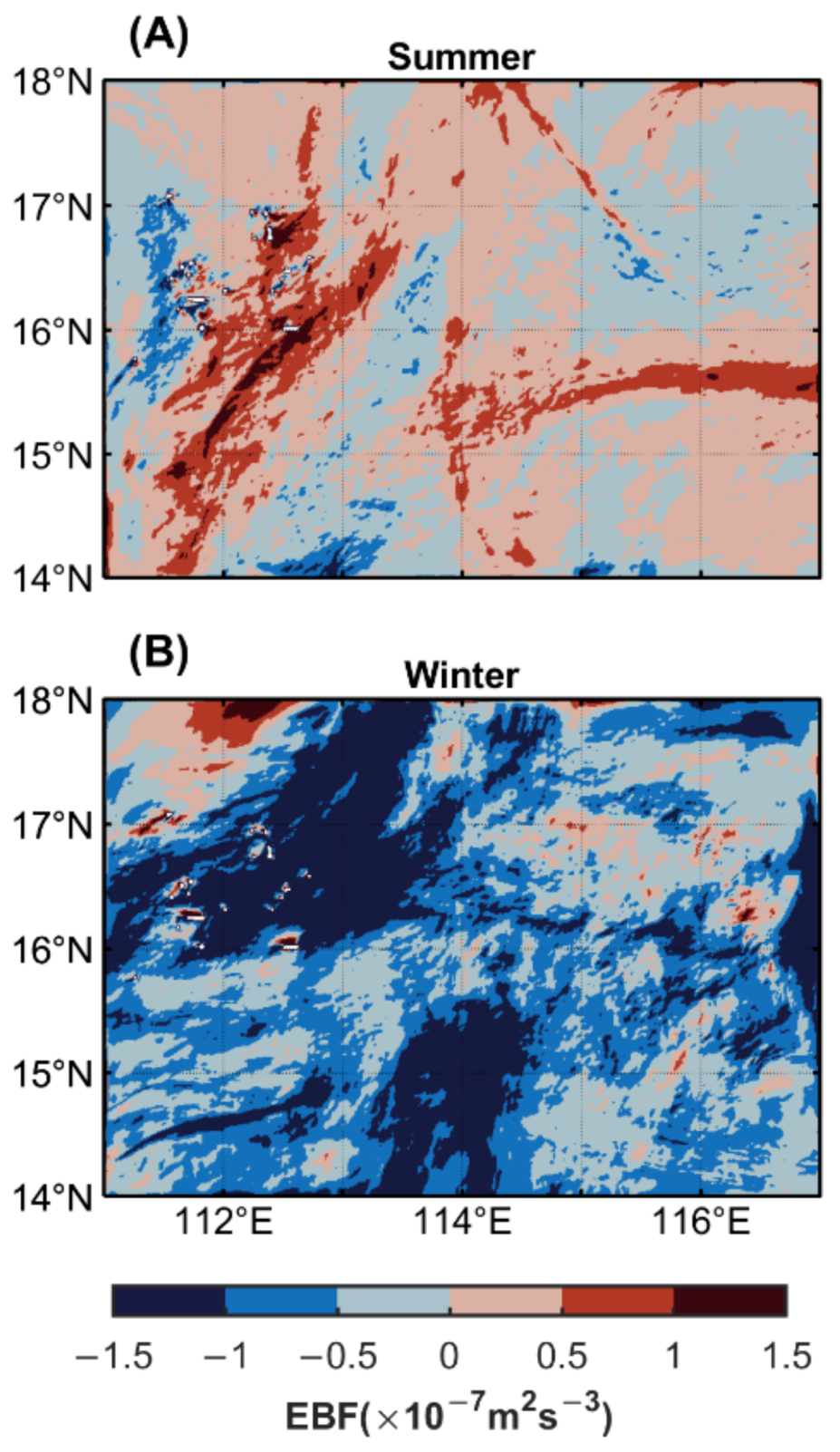
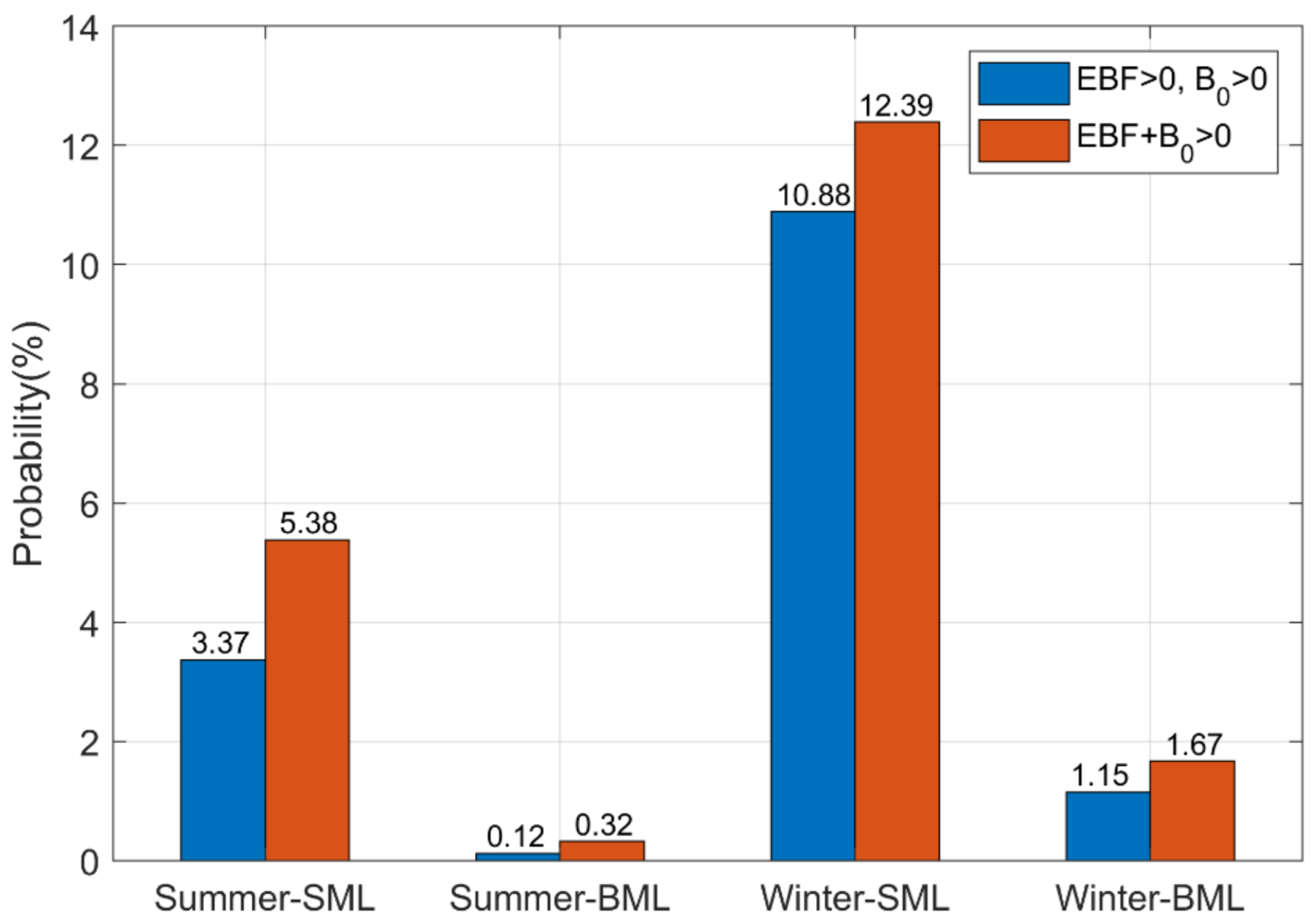
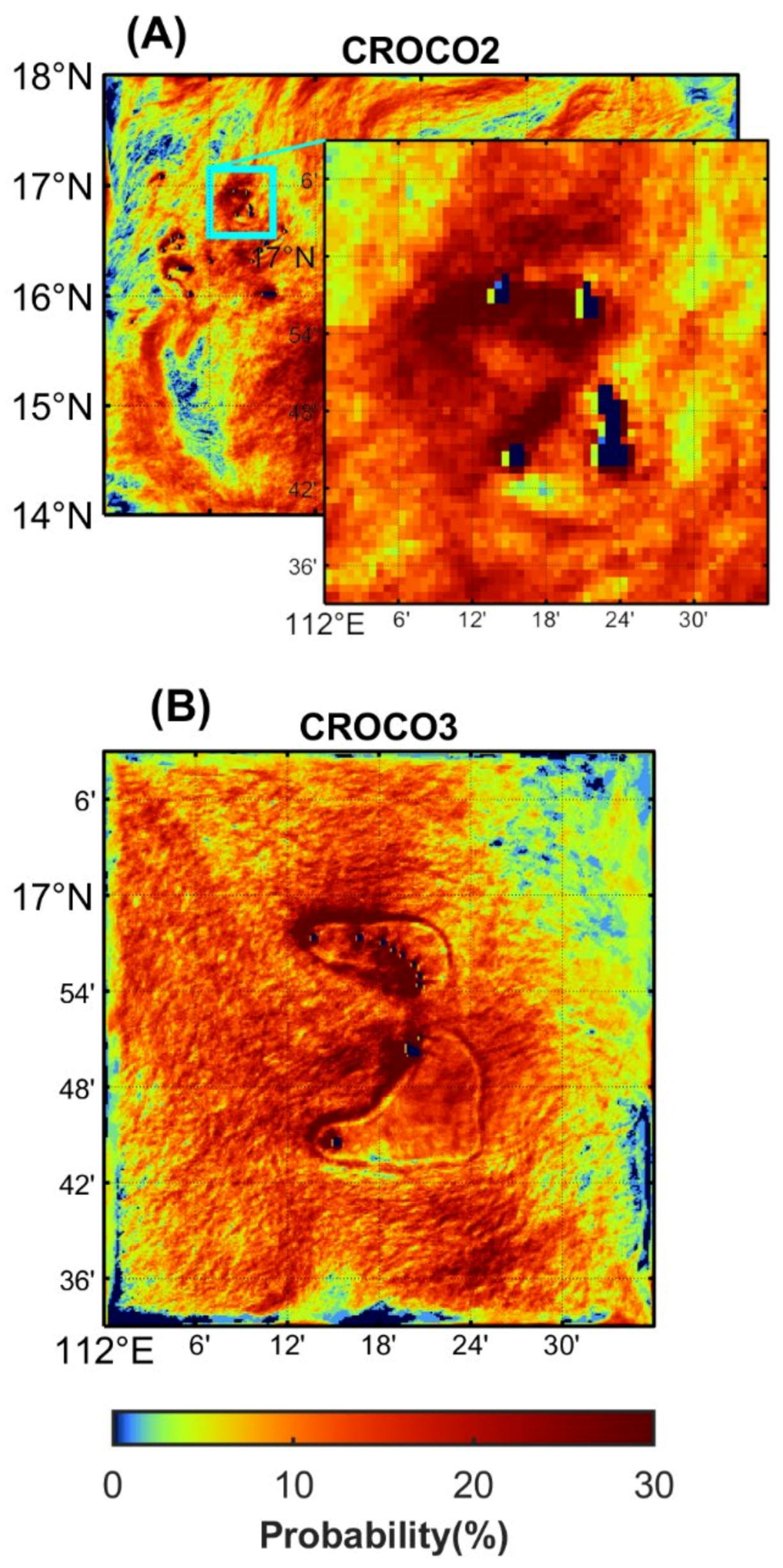
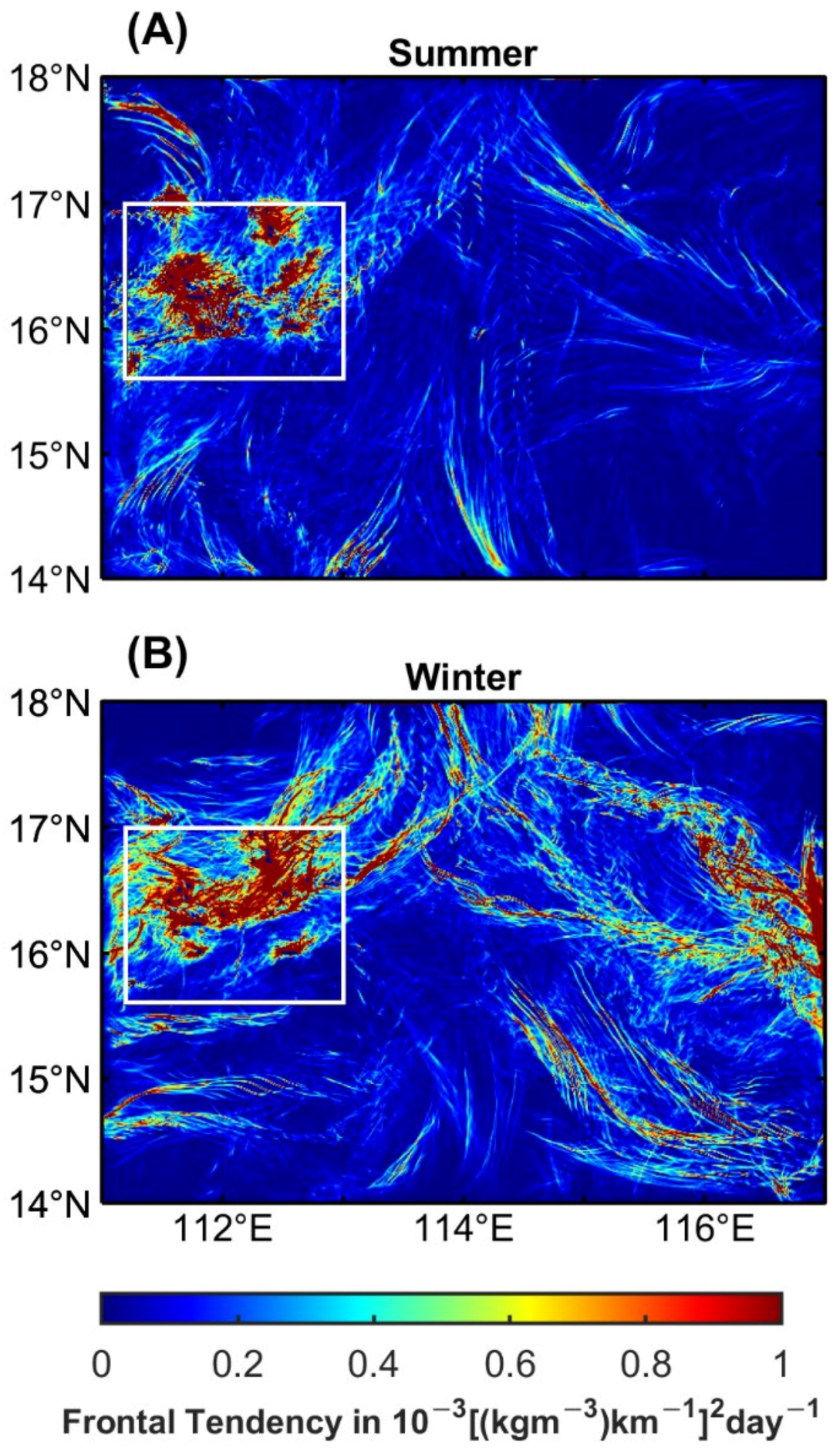
| Horizontal Resolution | Temporal Resolution | Time Interval | Variable | |
|---|---|---|---|---|
| ETOPO2 | 0.033° | — | — | Topographic height. |
| HYCOM | 0.083° | 3 h | January 2008–January 2020 | Potential temperature; salinity; velocity of currents; sea surface height. |
| CFSR | 0.312° | 6 h | January 2008–January 2011 | Air temperature at 2 m height above ground; specific humidity; precipitation; wind speed at 10 m height above ground; long- and short-wave flux. |
| CFSV2 | 0.205° | 6 h | January 2011–January 2020 | Same as the previous line. |
| TPXO8 | 0.033° | — | January 2008–January 2020 | M2, S2, K1, O1, N2, P1, K2, and Q1. |
Disclaimer/Publisher’s Note: The statements, opinions and data contained in all publications are solely those of the individual author(s) and contributor(s) and not of MDPI and/or the editor(s). MDPI and/or the editor(s) disclaim responsibility for any injury to people or property resulting from any ideas, methods, instructions or products referred to in the content. |
© 2023 by the authors. Licensee MDPI, Basel, Switzerland. This article is an open access article distributed under the terms and conditions of the Creative Commons Attribution (CC BY) license (https://creativecommons.org/licenses/by/4.0/).
Share and Cite
Jiang, Y.; Zhang, W.; Wang, H.; Zhang, X. Assessing the Spatio-Temporal Features and Mechanisms of Symmetric Instability Activity Probability in the Central Part of the South China Sea Based on a Regional Ocean Model. J. Mar. Sci. Eng. 2023, 11, 431. https://doi.org/10.3390/jmse11020431
Jiang Y, Zhang W, Wang H, Zhang X. Assessing the Spatio-Temporal Features and Mechanisms of Symmetric Instability Activity Probability in the Central Part of the South China Sea Based on a Regional Ocean Model. Journal of Marine Science and Engineering. 2023; 11(2):431. https://doi.org/10.3390/jmse11020431
Chicago/Turabian StyleJiang, Yifei, Weimin Zhang, Huizan Wang, and Xiaojiang Zhang. 2023. "Assessing the Spatio-Temporal Features and Mechanisms of Symmetric Instability Activity Probability in the Central Part of the South China Sea Based on a Regional Ocean Model" Journal of Marine Science and Engineering 11, no. 2: 431. https://doi.org/10.3390/jmse11020431
APA StyleJiang, Y., Zhang, W., Wang, H., & Zhang, X. (2023). Assessing the Spatio-Temporal Features and Mechanisms of Symmetric Instability Activity Probability in the Central Part of the South China Sea Based on a Regional Ocean Model. Journal of Marine Science and Engineering, 11(2), 431. https://doi.org/10.3390/jmse11020431







